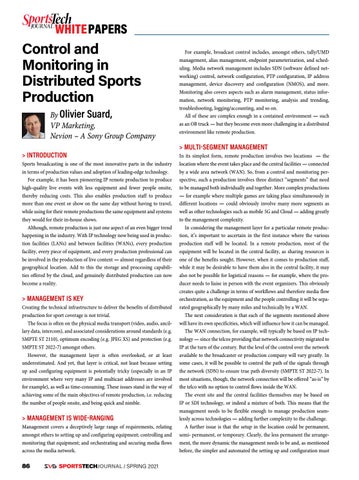WHITEPAPERS
Control and Monitoring in Distributed Sports Production By Olivier Suard, VP Marketing, Nevion – A Sony Group Company > INTRODUCTION Sports broadcasting is one of the most innovative parts in the industry in terms of production values and adoption of leading-edge technology. For example, it has been pioneering IP remote production to produce high-quality live events with less equipment and fewer people onsite, thereby reducing costs. This also enables production staff to produce more than one event or show on the same day without having to travel, while using for their remote productions the same equipment and systems they would for their in-house shows. Although, remote production is just one aspect of an even bigger trend happening in the industry. With IP technology now being used in production facilities (LANs) and between facilities (WANs), every production facility, every piece of equipment, and every production professional can be involved in the production of live content — almost regardless of their geographical location. Add to this the storage and processing capabilities offered by the cloud, and genuinely distributed production can now become a reality.
> MANAGEMENT IS KEY Creating the technical infrastructure to deliver the benefits of distributed production for sport coverage is not trivial. The focus is often on the physical media transport (video, audio, ancillary data, intercom), and associated considerations around standards (e.g. SMPTE ST 2110), optimum encoding (e.g. JPEG XS) and protection (e.g. SMPTE ST 2022-7) amongst others. However, the management layer is often overlooked, or at least underestimated. And yet, that layer is critical, not least because setting up and configuring equipment is potentially tricky (especially in an IP environment where very many IP and multicast addresses are involved for example), as well as time-consuming. These issues stand in the way of achieving some of the main objectives of remote production, i.e. reducing the number of people onsite, and being quick and nimble.
> MANAGEMENT IS WIDE-RANGING Management covers a deceptively large range of requirements, relating amongst others to setting up and configuring equipment; controlling and monitoring that equipment; and orchestrating and securing media flows across the media network.
86
SPORTSTECHJOURNAL / SPRING 2021
For example, broadcast control includes, amongst others, tally/UMD management, alias management, endpoint parameterization, and scheduling. Media network management includes SDN (software defined networking) control, network configuration, PTP configuration, IP address management, device discovery and configuration (NMOS), and more. Monitoring also covers aspects such as alarm management, status information, network monitoring, PTP monitoring, analysis and trending, troubleshooting, logging/accounting, and so on. All of these are complex enough in a contained environment — such as an OB truck — but they become even more challenging in a distributed environment like remote production.
> MULTI-SEGMENT MANAGEMENT In its simplest form, remote production involves two locations — the location where the event takes place and the central facilities — connected by a wide area network (WAN). So, from a control and monitoring perspective, such a production involves three distinct “segments” that need to be managed both individually and together. More complex productions — for example where multiple games are taking place simultaneously in different locations — could obviously involve many more segments as well as other technologies such as mobile 5G and Cloud — adding greatly to the management complexity. In considering the management layer for a particular remote production, it’s important to ascertain in the first instance where the various production staff will be located. In a remote production, most of the equipment will be located in the central facility, as sharing resources is one of the benefits sought. However, when it comes to production staff, while it may be desirable to have them also in the central facility, it may also not be possible for logistical reasons — for example, where the producer needs to liaise in person with the event organizers. This obviously creates quite a challenge in terms of workflows and therefore media flow orchestration, as the equipment and the people controlling it will be separated geographically by many miles and technically by a WAN. The next consideration is that each of the segments mentioned above will have its own specificities, which will influence how it can be managed. The WAN connection, for example, will typically be based on IP technology — since the telcos providing that network connectivity migrated to IP at the turn of the century. But the level of the control over the network available to the broadcaster or production company will vary greatly. In some cases, it will be possible to control the path of the signals through the network (SDN) to ensure true path diversity (SMPTE ST 2022-7). In most situations, though, the network connection will be offered “as-is” by the telco with no option to control flows inside the WAN. The event site and the central facilities themselves may be based on IP or SDI technology, or indeed a mixture of both. This means that the management needs to be flexible enough to manage production seamlessly across technologies — adding further complexity to the challenge. A further issue is that the setup in the location could be permanent, semi- permanent, or temporary. Clearly, the less permanent the arrangement, the more dynamic the management needs to be and, as mentioned before, the simpler and automated the setting up and configuration must
